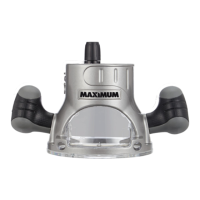27
RATE OF FEED (gs 19a and 19b)
The proper rate of feed depends on
several factors: the hardness and moisture
content of the workpiece, the depth of
cut, and the cutting diameter of the bit.
When cutting shallow grooves in soft
woods, such as pine, you may use a faster
rate of feed. When making deep cuts in
hardwoods, such as oak, you should use a
slower rate of feed.
FEEDING TOO RAPIDLY (g 19a)
Clean and smooth finished cuts can
only be achieved when the cutting bit is
rotating at a relatively high speed, taking
very small bites, and producing tiny,
clean-cut chips.
Forcing the feed of the cutting bit
forward too rapidly slows the revolution
of the cutting bit, and the bit takes larger
bites as it rotates. Larger bites mean
larger chips and a rough finish. This forcing action can also cause the router
motor to overheat.
Under extreme force-feeding conditions, the revolutions can become so slow
and the bites become so large that chips are only partially cut off, causing
splintering and gouging of the workpiece.
The router will make clean, smooth cuts if it is allowed to run freely without the
overload of forced feeding. You can detect forced feeding by the sound of the
motor. Its usual high-pitched whine will sound lower and stronger as it loses
speed. Holding the router against the workpiece will also be more difficult to do.
FEEDING TOO SLOWLY (g 19b)
When you feed the cutting bit too slowly, the rotating cutting bit does not cut
into new wood rapidly enough to take a bite. Instead, it scrapes away sawdust-
like particles. This scraping produces heat, which can glaze, burn, and mar the
cut in the workpiece and, in extreme cases, overheat the cutting bit.
When the cutting bit is scraping instead of cutting, the router is more difficult to
control as you feed it.
With almost no load on the motor, the cutting bit has a tendency to bounce
off the sides of the cut in the workpiece, producing a cut with a rippled finish
instead of clean, straight sides.
OPERATING INSTRUCTIONS
g 19a
Cut
Cutter
Bit Shank
TOO FAST
g 19b
Cut
Cutter
Bit Shank
TOO SLOW

